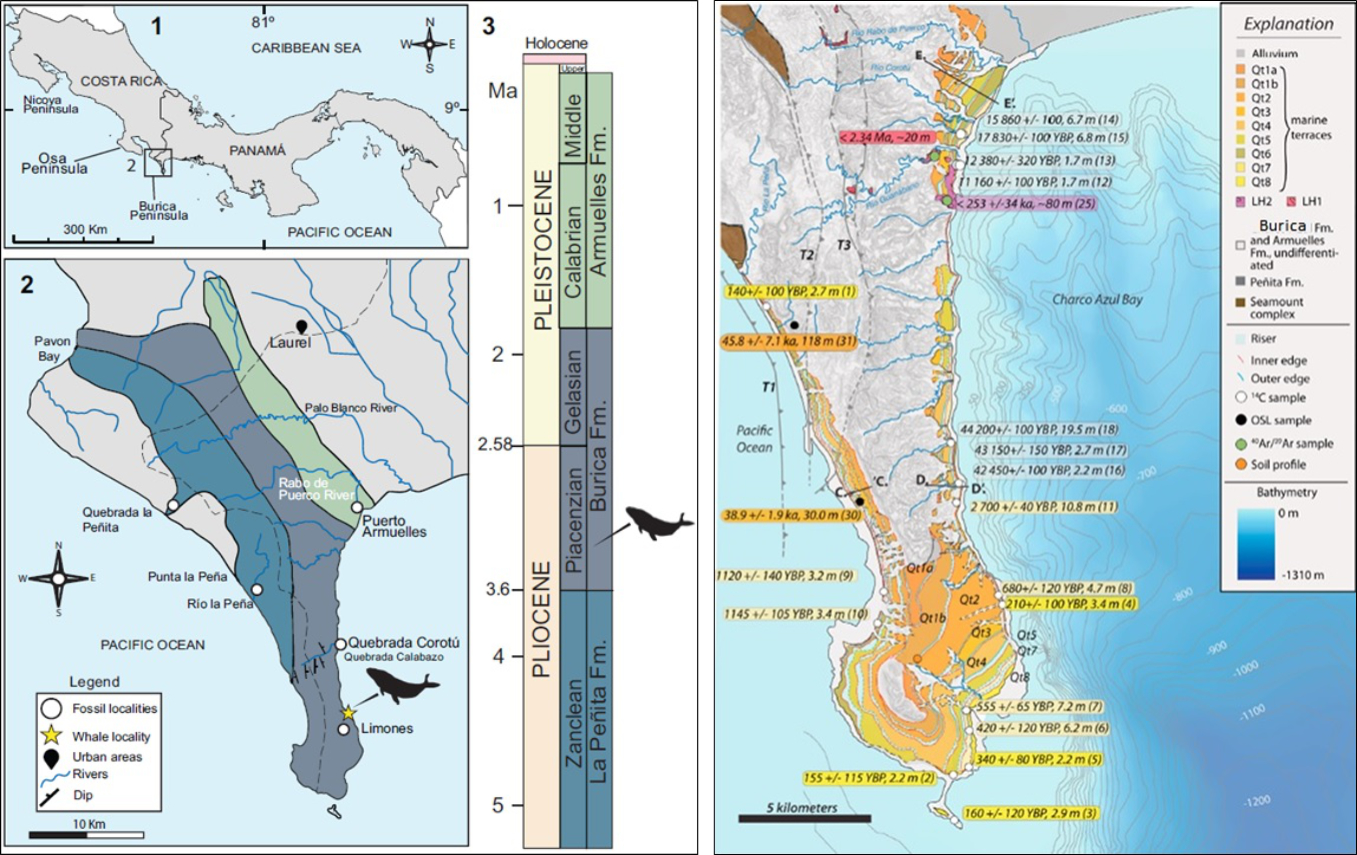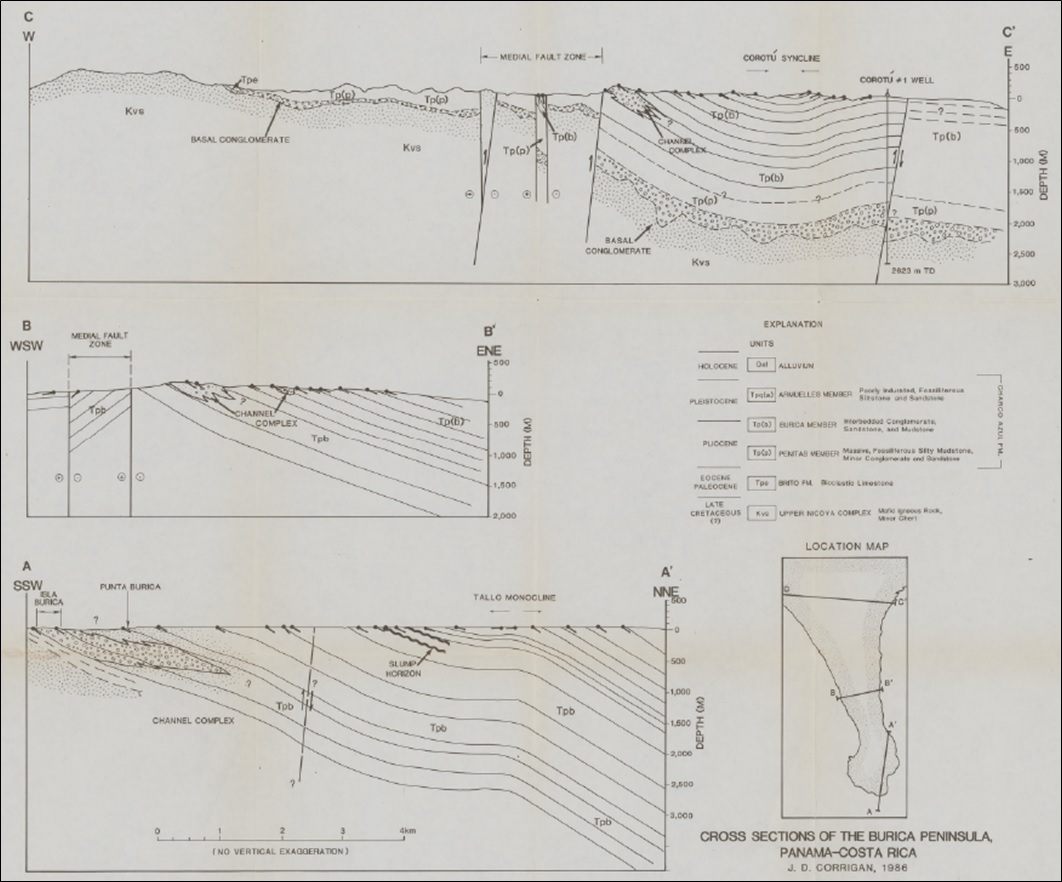Charco Azul Gr
Type Locality and Naming
Type Locality is at Burica Peninsula.
[Figure 1. Geological map of the Burica Peninsula showing the location of a Pliocene fossil whale found in the Burica Fm (Cortés et al. (2019)). Note also the dash line delineating the border between Costa Rica and Panama]
References:
See alternative in “Additional Information”
Synonym: Charco Azul Fm. NOTE: Ministerio de Comercio e Industrias (1991) and Instituto Geografico Nacional (IGN) "Tommy Guardia" (1996) have the whole Burica Peninsula sub-divided into different formation names (Charco Azul Fm, Gatún Fm -Uscari Fm, Senosri Fm - Uscari Fm, David Fm). Their history, background, and definition, however, are not described anywhere. The use of these names over the Burica Peninsula should be abandoned. Instead, the most recent formation names of La Peñita, Burica and Armuelles should be applied.
Lithology and Thickness
(1) the Early Pliocene Peñita Fm, which rests uncomformably upon basement rocks (in Costa Rica it also rests upon the Pavones Fm),
(2) the Late Pliocene Burica Fm, conformable on the Peñita Fm and
(3) the Early Pleistocene or younger Armuelles Fm, conformable on the Burica Fm (Figure 1).
The Peñita Fm is composed of as much of 1200 m of clayey, blue-green siltstone and litharenite consistently rich in benthic and planktic foraminifers, deposited in a forearc slope environment (Coates et al. (1992)). This basal formation is coarse with locally channelled conglomerates, some of which form a distinctive suite defined as the La Vaca Member by Coates et al. (1992). These coarse deposits record a detrital paralic and fan-delta depositional environment at the base of the Charco Azul Gr.
The Burica Fm consists of about 2800 m of mostly fine-grained, volcaniclastic turbidite deposits with local megabreccias formed by large-scale intraformational slumps (Coates et al. (1992)). The La Chancha Member is a distinctive coarse facies interpreted to represent canyon fill within the trench slope on which the Burica turbidites were deposited (Coates et al. (1992); Buchs (2008); Buchs et al. (2009)).
Finally, the Armuelles Fm consists of ~370 m of channelled pebbly conglomerate and unconsolidated greenish-blue litharenite and siltstone in the lower part and predominant grey-blue, clayed siltstone and fine litharenites in the upper part (Coates et al. (1992)).
Thickness: ~4500 m
[Figure 2. Cross-Sections of the Burica Peninsula, Panama-Costa Rica. Corrigan (1986).]
Relationships and Distribution
Lower contact
Upper contact
Regional extent
GeoJSON
Fossils
Age
Depositional setting
Additional Information
Synonym: Charco Azul Fm. NOTE: Ministerio de Comercio e Industrias (1991) and Instituto Geografico Nacional (IGN) "Tommy Guardia" (1996) have the whole Burica Peninsula sub-divided into different formation names (Charco Azul Fm, Gatún Fm -Uscari Fm, Senosri Fm - Uscari Fm, David Fm). Their history, background, and definition, however, are not described anywhere. The use of these names over the Burica Peninsula should be abandoned. Instead, the most recent formation names of La Peñita, Burica and Armuelles should be applied.
Lithology and Thickness: The Charco Azul Gr was comprehensively studied by Corrigan (1986) (Figure 048), Corrigan et al. (1990), Coates et al. (1992) and Collins et al. (1995). It has been subdivided into:
(1) the Early Pliocene Peñita Fm, which rests uncomformably upon basement rocks (in Costa Rica it also rests upon the Pavones Fm),
(2) the Late Pliocene Burica Fm, conformable on the Peñita Fm and
(3) the Early Pleistocene or younger Armuelles Fm, conformable on the Burica Fm (Figure 1).
The Peñita Fm is composed of as much of 1200 m of clayey, blue-green siltstone and litharenite consistently rich in benthic and planktic foraminifers, deposited in a forearc slope environment (Coates et al. (1992)). This basal formation is coarse with locally channelled conglomerates, some of which form a distinctive suite defined as the La Vaca Member by Coates et al. (1992). These coarse deposits record a detrital paralic and fan-delta depositional environment at the base of the Charco Azul Gr.
The Burica Fm consists of about 2800 m of mostly fine-grained, volcaniclastic turbidite deposits with local megabreccias formed by large-scale intraformational slumps (Coates et al. (1992)). The La Chancha Member is a distinctive coarse facies interpreted to represent canyon fill within the trench slope on which the Burica turbidites were deposited (Coates et al. (1992); Buchs (2008); Buchs et al. (2009)).
Finally, the Armuelles Fm consists of ~370 m of channelled pebbly conglomerate and unconsolidated greenish-blue litharenite and siltstone in the lower part and predominant grey-blue, clayed siltstone and fine litharenites in the upper part (Coates et al. (1992)).
Thickness: ~4500 m
[Figure 2. Cross-Sections of the Burica Peninsula, Panama-Costa Rica. Corrigan (1986).]
Lithology-pattern: Siltstone
Relationships and Distribution:
Lower contact: Basement rocks
Upper contact: Monte Verde Fm
Regional extent: (Geo-JSON is left empty on purpose)
GeoJSON:
Fossils: See details of each formation belonging to the Gr (La Peñita Fm, Burica Fm and Armuelles Fm).
Age: Between the Early Pliocene and the Pleistocene (Coates et al. (1992); Collins et al. (1995))
Age span:
Beginning stage: Zanclean
Fraction up in beginning stage: 0
Beginning date (Ma):
Ending stage: Lt. Pleist.
Fraction up in ending stage: 0
Ending date (Ma):
Depositional setting: The Charco Azul Gr defines a transgressive–regressive cycle between the Early Pliocene and the Pleistocene (Coates et al. (1992); Collins et al. (1995))
Depositional-pattern:
Additional Information
- Olsson (1942a). Base is heavy conglomerate, grades upward into sandstones and foraminiferal shales. Maximum thickness more than 4,000 feet. Overlies Armuelles ,. Pliocene.
- Coryell et al. (1942); Terry (1956, pgs 55-59); Wilson et al. (1957);
- Woodring (1960). The Charco Azul Gr, consisting chiefly of foraminiferal siltstone, crops out along the shore of Charco Azul Bay elsewhere in the Burica Peninsula. It grades downward into sandstone of the Burica Fm or overlaps that formation and rests on Eocene limestone or the pre-Tertiary basement. The maximum thickness is about 4,000 feet. Foraminifera and mollusks represent a fairly deep-water facies and indicate a Pliocene age. The foraminifera have been described by Coryell et al. (1942) and the mollusks by Olsson (1942a). These include Bolivina foraminata, B. pomposa, Cassidulina californica, Hanetia alternata, Cancellaria terryi, Acila isthmica burica, and Macoma medioamericana.
- Obando (1986); Jung (1989);
- Corrigan et al. (1990) named and redefined the “Charco Azul F,” as the interval which included the La Peñita, Burica and Armuelles Members. Later, this “Charco Azul Fm,” was renamed as a Group, while each of its members were given the designation of “Formation”.
- Coates et al. (1992); Kolarsky (1992); Collins et al. (1995); Schlegel (1996); O'Dea et al. (2007) ; Leon-Rodríguez (2007); Hendy et al. (2008); Buchs (2008); Buchs et al. (2009); Beu (2010); Morell et al. (2011); De Gracia et al. (2012); Cortés et al. (2019); Timmons (2019).

